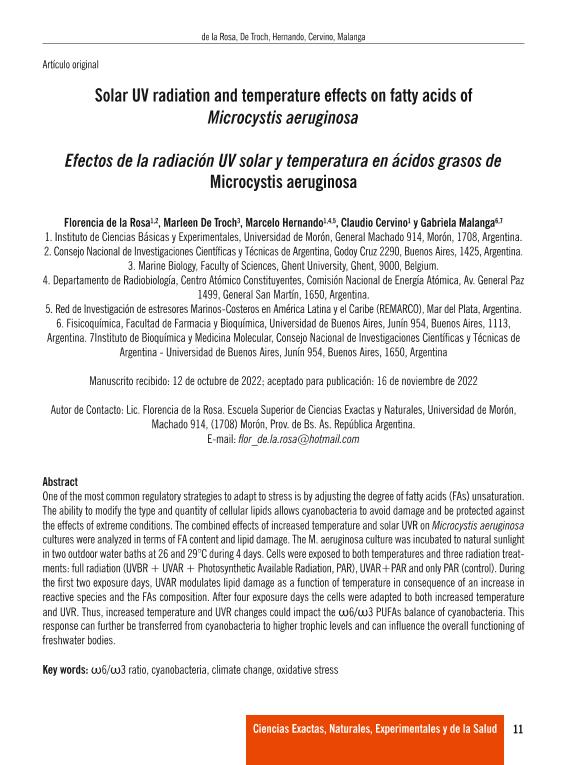Artículo
Una de las estrategias regulatorias más conocidas para adaptarse al estrés comprende ajustar el grado de insaturación de los ácidos grasos (AG). La capacidad de modificar el tipo y la cantidad de lípidos en la membrana permite a las cianobacterias evitar daños y estar protegidas contra los efectos de condiciones extremas. Los efectos combinados del aumento de la temperatura y la radiación UV solar en cultivos de Microcystis aeruginosa se analizaron en términos de contenido de AG y daño de lípidos. El cultivo de M. aeruginosa se incubó a la luz solar natural en dos baños termostáticos a 26 y 29°C durante 4 días. Las células se expusieron a ambas temperaturas y tres tratamientos de radiación: radiación completa (RUVB + RUVA + radiación fotosintéticamente activa, RFA), RUVA+RFA y solo RFA (control). Se encontró durante los dos primeros días de exposición, que la RUVA modula el daño lipídico en función de la temperatura como consecuencia de un aumento de las especies reactivas y de la composición de AGs. Después de cuatro días de exposición, las células se adaptaron tanto al aumento de temperatura como a la radiación UV. Por lo tanto, el aumento de la temperatura y los cambios de RUV podrían afectar el equilibrio de AGPI ω6/ω3 de las cianobacterias. Esta respuesta podría transferirse, inclusive a niveles tróficos superiores e influir en el funcionamiento general de los cuerpos de agua dulce. One of the most common regulatory strategies to adapt to stress is by adjusting the degree of fatty acids (FAs) unsaturation. The ability to modify the type and quantity of cellular lipids allows cyanobacteria to avoid damage and be protected against the effects of extreme conditions. The combined effects of increased temperature and solar UVR on Microcystis aeruginosa cultures were analyzed in terms of FA content and lipid damage. The M. aeruginosa culture was incubated to natural sunlight in two outdoor water baths at 26 and 29°C during 4 days. Cells were exposed to both temperatures and three radiation treatments: full radiation (UVBR + UVAR + Photosynthetic Available Radiation, PAR), UVAR+PAR and only PAR (control). During the first two exposure days, UVAR modulates lipid damage as a function of temperature in consequence of an increase in reactive species and the FAs composition. After four exposure days the cells were adapted to both increased temperature and UVR. Thus, increased temperature and UVR changes could impact the ω6/ω3 PUFAs balance of cyanobacteria. This response can further be transferred from cyanobacteria to higher trophic levels and can influence the overall functioning of freshwater bodies.
Solar UV radiation and temperature effects on fatty acids of Microcystis aeruginosa
de la Rosa, Florencia Grisel ; De Troch, Marleen; Hernando, Marcelo Pablo
; De Troch, Marleen; Hernando, Marcelo Pablo ; Cervino, Claudio Osvaldo; Malanga, Gabriela Fabiana
; Cervino, Claudio Osvaldo; Malanga, Gabriela Fabiana
 ; De Troch, Marleen; Hernando, Marcelo Pablo
; De Troch, Marleen; Hernando, Marcelo Pablo ; Cervino, Claudio Osvaldo; Malanga, Gabriela Fabiana
; Cervino, Claudio Osvaldo; Malanga, Gabriela Fabiana
Fecha de publicación:
10/2022
Editorial:
Universidad de Morón
Revista:
Revista de Investigaciones Científicas de la Universidad de Morón
ISSN:
2591-5444
Idioma:
Inglés
Tipo de recurso:
Artículo publicado
Clasificación temática:
Resumen
Palabras clave:
OMEGA6/OMEGA3 RATIO
,
CYANOBACTERIA
,
CLIMATE CHANGE
,
OXIDATIVE STRESS
Archivos asociados
Licencia
Identificadores
Colecciones
Articulos(IBIMOL)
Articulos de INSTITUTO DE BIOQUIMICA Y MEDICINA MOLECULAR
Articulos de INSTITUTO DE BIOQUIMICA Y MEDICINA MOLECULAR
Articulos(SEDE CENTRAL)
Articulos de SEDE CENTRAL
Articulos de SEDE CENTRAL
Citación
de la Rosa, Florencia Grisel; De Troch, Marleen; Hernando, Marcelo Pablo; Cervino, Claudio Osvaldo; Malanga, Gabriela Fabiana; Solar UV radiation and temperature effects on fatty acids of Microcystis aeruginosa; Universidad de Morón; Revista de Investigaciones Científicas de la Universidad de Morón; 11; 10-2022; 11-23
Compartir
Altmétricas



